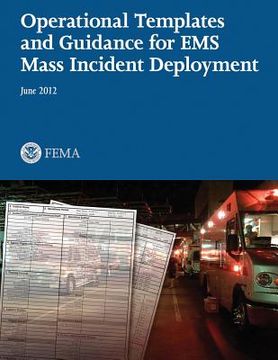Reseña del libro "Operational Templates and Guidance for EMS Mass Incident Deployment (en Inglés)"
Emergency Medical Services (EMS) agencies regardless of service delivery model have sought guidance on how to better integrate their emergency preparedness and response activities into similar processes occurring at the local, regional, State, tribal and Federal levels. The primary purpose of this project is to begin the process of providing that guidance as it relates to mass care incident deployment. The World Bank reported in 2005 that on aggregate, the reported number of natural disasters worldwide has been rapidly increasing, from fewer than 100 in 1975 to more than 400 in 2005. Terrorism, pandemic surge, and natural disasters have had a major impact on the science of planning for and responding to mass care incidents and remain a significant threat to the homeland. From the attacks of September 11th, 2001, the subsequent use of anthrax as a biological weapon, to the more recent surge concerns following the outbreak of H1N1 influenza, EMS have a real and immediate need for integration with the emergency management process, and to coordinate efforts with partners across the spectrum of the response community. The barriers identified from the literature review and interviews with national EMS leadership include: lack of access to emergency preparedness grant funding; underrepresentation on local, regional, and State level planning committees; and lack of systematic mandatory inclusion of all EMS provider types in State, regional, and local emergency plans. In December 2004, New York University's Center for Catastrophe Preparedness and Response held a national roundtable that included experts from major organizations representing the EMS system as a whole. The report from that meeting concluded that: "EMS providers, such as fire departments and hospital-based, commercial, and air ambulance services, ensure that patients receive the medical care they need during a terrorist attack. While EMS personnel, including Emergency Medical Technicians and paramedics, represent roughly one-third of traditional first responders (which also include law enforcement and fire service personnel), the EMS system receives only four percent of first responder funding. If EMS personnel are not prepared for a terrorist attack, their ability to provide medical care and transport to victims of an attack will be compromised. There will be an inadequate medical first response." In 2007, the Institute of Medicine in its landmark report Emergency Medical Services at the Crossroads issued a recommendation that stated: "The Department of Health and Human Services (DHHS), the Department of Homeland Security and the States should elevate emergency and trauma care to a position of parity with other public safety entities in disaster planning and operations." Since the time of these reports Federal progress to address these issues has included the creation of the Office of Health Affairs (OHA) within the Department of Homeland Security (DHS), the creation of the Emergency Care Coordination Center (ECCC) within HHS, and the creation of the Federal Interagency Committee on EMS (FICEMS) Preparedness Committee. In an effort to increase the level of preparedness among EMS agencies, the National Emergency Medical Services Management Association (NEMSMA) approached the DHS and OHA to engage them in a partnership that would provide a greater understanding of the shortfalls in EMS emergency preparedness and provide resources to fill those gaps. The primary objective of this project is to understand model policies and practices across a spectrum of disciplines and provider types that will lead to a better prepared EMS deployment to mass care incidents. This project should serve as a foundation for further development of EMS specific policies and templates that improve EMS readiness to manage the full spectrum of hazards that face their communities.

